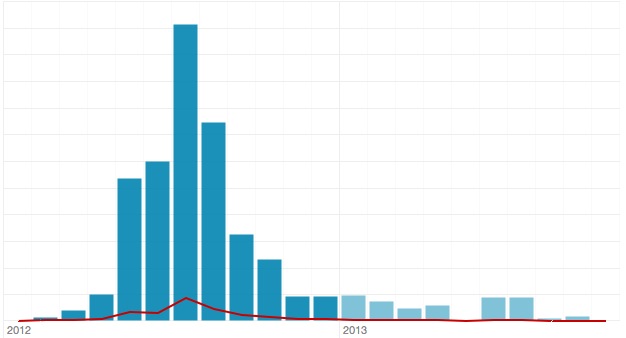 Today we are happy to share some time with the excellent photographer Troels Haahr Graugaard!
Today we are happy to share some time with the excellent photographer Troels Haahr Graugaard!
You certainly all know his great pictures on iStock which he sells under his company name Squared Pixels. We are happy to welcome him to our blog’s interview series and hope you enjoy learning from him!
Tell us, where do you live and where are you from? Is that where you produce your photography?
I was born and raised in Denmark. I currently reside in Aarhus, Denmark, and up until now I have produced most of my images in Cape Town, South Africa. Though a small part of my production I have done here in Denmark and also in London.
When did you discover your interest in photography?
I was studying Sports Science in Aalborg, Denmark, back in 2008 when I for some reason one day felt a sudden urge to buy my first D-SLR camera and start taking pictures.
At first I took pictures of nature, then started doing some shots of friends and family -and then part time models. Just soon after first really discovering photography I was spending way more time on taking pictures, image editing and thinking about photography than the time spent on my studies – naturally (to me at least), I started trying to figure out how I could make photography my way of living.
Ultimately, that led me to drop out of college in 2009 to follow the dream of becoming a professional photographer (I did find my opening before dropping out though!).
Looking back, it feels quite abrupt how I got into photography in the first place and there seems to be no real explanation as to why this sudden obsession with taking photos grabbed me. I simply enjoyed, and this interest has stayed with me ever since.
How did you find microstock and why did you get involved? Has it changed your life?
One of my friends told me about this guy who was living in Aarhus and earning his money (and a lot of them!) selling images off the internet. His name was Yuri Arcurs and apparently a big name in microstock.
It seemed to me an interesting concept selling images off the internet, mostly, of course, because it seemed to be able to offer an opportunity to turn the hobby of mine into a living. I decided to send him an unsolicited application, and this led me to becoming his assistant and apprentice at the same time.
My way into the microstock world definitely changed my life in some ways. I don’t really speculate about how my life would have been had I not got involved in it.
It hasn’t changed my beliefs and ideas about the world, but to go from being a Sports Science student, with a likely perspective of becoming a high school teacher, to being a full time stock photographer, I would say, is a bit of a change in terms of career and perspectives. Earning a living from microstock has allowed me to experience things and go places I probably wouldn’t have gone if hadn’t taken the leap of faith back then in 2009.
Thank you for image! What inspired you to take this picture?
You’re most welcome.
I have a friend who’s an avid swimmer, and for a long time I was thinking about doing an underwater shoot with him, merely for the fun of it. I rented the local swimming stadium for a couple of hours, grabbed two daylight balanced, consistent light sources and really had a blast shooting underwater for the first time.
Initially I didn’t think of stock at all when I shot the images, but I must be stock photography-brainwashed because the images turned out to be perfect stock-material.
I ended up uploading the images to my account on iStock, and in the following months this particular image skyrocketed. During the Olympics in July last year it reached its peak. I wish I could say that I had planned the shoot specifically for the olympics and uploaded it just at the right time – but it was a total coincidence and the Olympics hadn’t crossed my mind even once. So much for being a ‘pro’, right?
What does this image’s revenue chart tell you?
It tells me that there’s a special need for good images of competitive swimmers (or any sport for that matter) during the olympics – and perhaps other big sport events as well.
Did you expect such a revenue chart? Are you happy with it?
I didn’t expect much at all from this image. So, yeah, it turned out as a happy surprise.
The microstock market is huge. How do you analyze the market? Is it an important part of your workflow?
Analyzing the market should be a big part of every stock photographer’s workflow or else you could easily be doing a lot of hard work for nothing. My last four years have been very stock-intensive in the sense that I have been talking and reading full time about the world of stock images.
I’ve built up a pretty good general knowledge of what sells and what doesn’t, but Stock Performer, best match search on iStock and other pages, creative briefs, needs of customers, all sorts of commercials and news in television and news-sources help me keep me on my toes – hopefully to produce some up-to-date content for my portfolio.
Do you believe in “quantity” or “quality”? What is most important for you and why?
I think I’ve finally found a good balance between quantity and quality.
When I look at the images I uploaded in the start of my stock career it makes my toes curl. The technical quality is good but there are way too many images that could go for being a dupe and the usability of some of the images is questionable.
My shooting style has become more mature and I try to make my images look more authentic and believable and less generic. Instead of making a location look like it’s a hospital/old age home/whatever I now try to go out and find locations that actually suit the aim of the shoot. I’m looking for a nice balance between quality and quantity.
What does your typical production process look like?
Normally, I produce my images with a team of freelancers that I hire for each job.
I always have a professional makeup-artist, stylist and an assistant on set – and more than one assistant if it’s a big shoot. I do all the preplanning like analyzing what to shoot and making a shoot plan, finding the right location(sometimes I have a location scout)and finding the right models. I find a stylist and discuss the styling and let her or him find all the clothes and props needed for the shoot.
Finding the right stylist is really important to me as she/he have a lot of responsibility and if possible I prefer to work with the same stylist from shoot to shoot. It’s important that we have a good chemistry and the stylist knows me, stock-styling and my working habits. In that way the shoot will run much more smoothly and be less stress-inducing. The MUA and the Assistant is less difficult to replace but it is still important for me to hold on to people that I know have the right professional attitude.
Would you recommend photographers to take risks and invest in employees or assistants, or outsource, to help them in their production process?
I’m a big believer in outsourcing work if your budget allows it. I outsource retouching, key wording and uploading and I’m also thinking about outsourcing the developing and editing of my images as well. It saves me a lot of time in front of the screen that I can spend more effectively elsewhere and ultimately be able to shoot more and have more time on my hands to do other fun stuff unrelated to stock. You increase your expenses but decrease redundant work and increase the quality of your work and your life. That’s my personal experience at least.
Where do you think the stock photography business is going? How do you see the next years?
Well, change is inevitably gonna come, and it is almost entirely how willing you are to adapt and see what’s coming that will decide just how successful you will be. This of course could be applied to a lot of areas in life. I want to be careful predicting anything because I think the future is a very abstract subject to be talking about. I feel like my guess would be just as good/bad as anyone’s.
In the short run I think the business model of Shutterstock will help them grow even bigger, bringing more benefits to certain buyers of stock but less income for us – the suppliers of stock images. Stock photographers will have to make a choice – where do we want to be? Personally, I couldn’t produce the same amount of files with the same high quality as now if iStock switched to Shutterstock’s pricing model. iStock and Shutterstock are going two different ways and you can’t really compare them anymore. I feel good being on the path iStock has chosen.
And then there’s mobile phone photography. The quality of the images coming out of a cell phone is good for some shots, and I have no doubt that those shots can be sold for stock. For now, I think it will mostly be editorial that is going to benefit from it. But there’s no doubt that the potential of shooting good lifestyle imagery with a phone is growing each time a new phone is released on the market. Who knows(God?) how it’ll look 5-10-15 years from now. Nevertheless, I think there’ll always be a place and income for photographers like me that consistently analyze, plan and execute high value shoots.
What is your advice to remain a successful stock photographer in upcoming years?
Focus more on high quality images; to go an extra mile with future images, better models, styling, location, and concept. With the changes I see going on in the stock image market, I’m thinking to let the waters part and focus on being in the high end. And then remember to have fun while shooting, be playful and relaxed and it will reflect in the images you make.
Tell us, when you are not doing photography, how do you relax and enjoy your free time? I run, bike, do yoga, read, go to café’s, hang out with friends and family, listen to music and I also sometimes like to travel without taking my precious camera with me.
Thank you very much for your time, it was a pleasure talking to you!
If you haven’t joined Stock Performer yet, join the free trial now!
You enjoyed this interview? Press here to read more about successful microstockers!


Webmentions
[…] Troels Haahr Graugaard from SquaredPixels […]